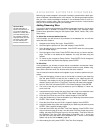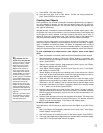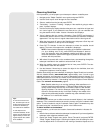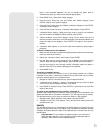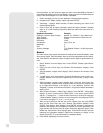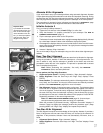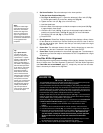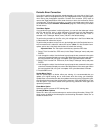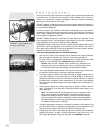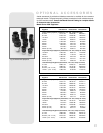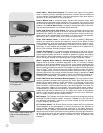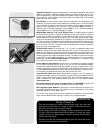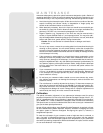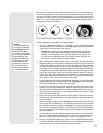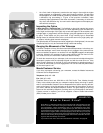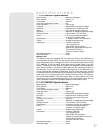
40
You may perform through-the-telescope photography with any 35mm camera body with
a removable lens. You may connect a camera to a #62 T-Adapter which is then con-
nected to the microfocuser assembly. See Fig. 21. Using this method, the telescope
effectively becomes the lens of the camera.
The #62 T-Adapter (1, Fig. 21) connects to the microfocuser assembly, followed by a
T-Mount (2, Fig. 21) for the particular brand of 35mm camera being used, followed by
the camera body (3, Fig. 21).
To orient an object in the viewfinder of the 35mm camera body, use a small jeweler’s
screwdriver to slightly loosen three adjustment screws around the outer knurled ring
of the T-Mount. Rotate the camera body to achieve proper orientation of the object;
then re-tighten the adjustment screws.
The #62 T-Adapter permits close-coupling of a camera body to the telescope. In this
format vignetting occurs: The photographic image appears on film with a slight dark-
ening (vignetting) at the corners of the 35mm frame (Fig. 22).
Photography through a long lens such as the
LX200GPS requires special technique for
good results, and the photographer should probably expect to waste a roll or two of
film in acquiring this technique. Long-lens photography has its own rewards, however,
rewards that short-focus lenses cannot duplicate.
A few tips on photography with the
LX200GPS telescopes:
1. Use the Field Tripod for the telescope. At an effective focal length of 2000mm,
even small external vibrations can easily ruin an otherwise good photo.
For best results in photographing celestial objects, a wedge and One-Star polar
alignment is recommended. See
APPENDIX A, pages 50 through 54.
Caution: With the #62 T-Adapter and a camera body mounted to the
LX200GPS photo port, the telescope can only be rotated vertically about
45°. Moving past this point may damage the telescope and camera.
2. Use a cable-operated shutter release. Touching the camera body to initiate shut-
ter operation almost certainly introduces undesirable vibrations.
3. Focus the image with extreme care. While observing the subject through the cam-
era’s reflex viewfinder, turn the telescope’s focus knob (6, Fig. 1) to achieve the
sharpest possible focus. Note that some 35mm cameras may have an optional
focusing screen (available from the manufacturer) for use with a long telephoto
lens. This screen provides a brighter and clearer image to focus, and is highly rec-
ommended.
4. Correct shutter speeds vary widely, depending on lighting conditions and film
used. Trial-and-error is the best way to determine proper shutter speed in any
given application.
Note: The camera used with your telescope may have an exposure meter
that is still active when the standard lens is removed and the body is con-
nected to the telescope with the T-Mount. If used for terrestrial photogra-
phy, the camera meter should be acceptable. If used for astrophotography,
the meter probably will not provide good results since camera meters are
not made to compensate for a dark sky.
5. Terrestrial photography through the
LX200GPS is sensitive to heat waves rising
from the Earth’s surface. Long distance photography is best accomplished in the
early morning hours before the Earth has had time to build up heat.
6. Photography of the Moon and planets through the LX200GPS can be especially
gratifying, but points 1 through 4 should be particularly noted in this case. If you
wish to take photographs using polar alignment, see
APPENDIX A, page 50.
2
Fig. 21: LX200GPS with #62
T-Adapter: (1) camera adapter, (2) T-
mount, (3) camera body.
Fig. 22: Example of vignetting.
1
PHOTOGRAPHY
3



